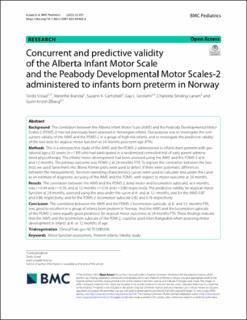| dc.contributor.author | Ustad, Tordis | |
| dc.contributor.author | Brandal, Merethe | |
| dc.contributor.author | Campbell, Suzann K | |
| dc.contributor.author | Girolami, Gay L | |
| dc.contributor.author | Sinding-Larsen, Charlotte | |
| dc.contributor.author | Øberg, Gunn Kristin | |
| dc.date.accessioned | 2023-11-30T07:22:39Z | |
| dc.date.available | 2023-11-30T07:22:39Z | |
| dc.date.created | 2023-11-29T12:48:52Z | |
| dc.date.issued | 2023 | |
| dc.identifier.issn | 1471-2431 | |
| dc.identifier.uri | https://hdl.handle.net/11250/3105300 | |
| dc.description.abstract | Background
The correlation between the Alberta Infant Motor Scale (AIMS) and the Peabody Developmental Motor Scales-2 (PDMS-2) has not previously been assessed in Norwegian infants. Our purpose was to investigate the concurrent validity of the AIMS and the PDMS-2 in a group of high-risk infants, and to investigate the predictive validity of the two tests for atypical motor function at 24 months post term age (PTA).
Methods
This is a retrospective study of the AIMS and the PDMS-2 administered to infants born preterm with gestational age ≤ 32 weeks (n = 139) who had participated in a randomized controlled trial of early parent-administered physiotherapy. The infants’ motor development had been assessed using the AIMS and the PDMS-2 at 6- and 12-months. The primary outcome was PDMS-2 at 24-months PTA. To explore the correlation between the two tests we used Spearman’s rho. Bland Altman plots were used to detect if there were systematic differences between the measurements. Receiver-operating characteristics curves were used to calculate area under the curve as an estimate of diagnostic accuracy of the AIMS and the PDMS- with respect to motor outcome at 24 months.
Results
The correlation between the AIMS and the PDMS-2 (total motor and locomotion subscale), at 6 months, was r = 0.44 and r = 0.76, and at 12 months r = 0.56 and r = 0.80 respectively. The predictive validity for atypical motor function at 24 months, assessed using the area under the curve at 6- and at 12- months, was for the AIMS 0.87 and 0.86, respectively, and for the PDMS-2 locomotion subscale 0.82 and 0.76 respectively.
Conclusion
The correlation between the AIMS and the PDMS-2 locomotion subscale, at 6- and 12- months PTA, was good to excellent in a group of infants born preterm in Norway. And the AIMS and the locomotion subscale of the PDMS-2 were equally good predictors for atypical motor outcomes at 24 months PTA. These findings indicate that the AIMS and the locomotion subscale of the PDM-2, could be used interchangeable when assessing motor development in infants at 6- or 12 months of age. | en_US |
| dc.language.iso | eng | en_US |
| dc.publisher | BioMed Central Ltd. | en_US |
| dc.rights | Navngivelse 4.0 Internasjonal | * |
| dc.rights.uri | http://creativecommons.org/licenses/by/4.0/deed.no | * |
| dc.title | Concurrent and predictive validity of the Alberta Infant Motor Scale and the Peabody Developmental Motor Scales-2 administered to infants born preterm in Norway | en_US |
| dc.title.alternative | Concurrent and predictive validity of the Alberta Infant Motor Scale and the Peabody Developmental Motor Scales-2 administered to infants born preterm in Norway | en_US |
| dc.type | Peer reviewed | en_US |
| dc.type | Journal article | en_US |
| dc.description.version | publishedVersion | en_US |
| dc.source.volume | 23 | en_US |
| dc.source.journal | BMC Pediatrics | en_US |
| dc.identifier.doi | 10.1186/s12887-023-04402-6 | |
| dc.identifier.cristin | 2205147 | |
| dc.source.articlenumber | 591 | en_US |
| cristin.ispublished | true | |
| cristin.fulltext | original | |
| cristin.qualitycode | 1 | |

